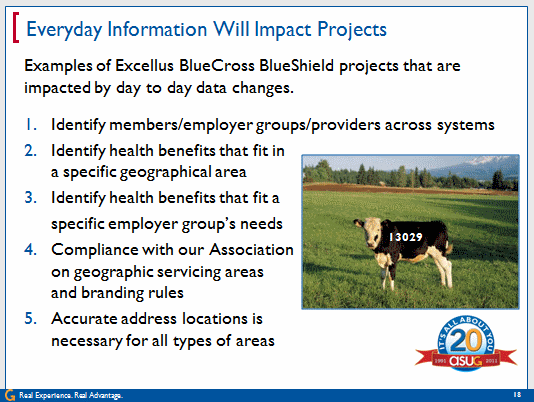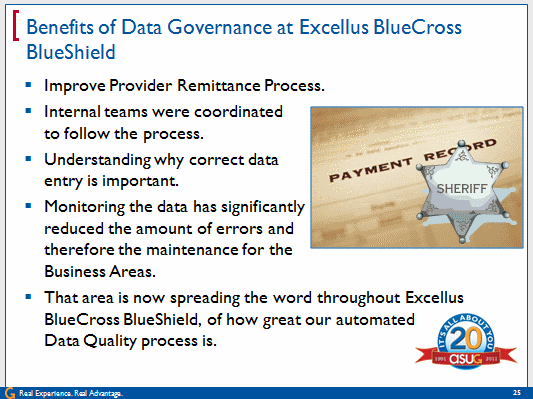
- SAP Community
- Products and Technology
- Additional Blogs by SAP
- Information Governance in Insurance: How To Establ...
- Subscribe to RSS Feed
- Mark as New
- Mark as Read
- Bookmark
- Subscribe
- Printer Friendly Page
- Report Inappropriate Content
To set the stage, Excellus BlueCross BlueShield is a Lifetime Healthcare company affiliated with BlueCross BlueShield. This affiliation means that they are mostly independent, but must comply with BlueCross BlueShield rules. Independence means that the Syracuse, NY, group decided to build success by starting on a local project with hard ROI. Because of this initial target, the group could define their mission and roles in a more controlled, local environment.

The first definition of information governance is more broad and comprehensive than Excellus BlueCross BlueShield was willing to initially sign up for. It includes actively governing rich content (like documents) and retention/archiving policies. Excellus BlueCross BlueShield chose a narrower focus of data governance, with specific attention on data quality policies and root cause analysis.
At Excellus BlueCross BlueShield, the classic core competencies of the Data Governance group include responsibility for processes, metrics, and data standards. The group does also recognize the key part that metadata plays in data governance. Finally, notice #7: Data quality consultation and analysis. #7 is all about the root cause analysis…when something goes wrong, how do you figure out what went wrong? The group also makes recommendations on how to fix the data, the process that caused bad data, and metrics to verify continued levels of quality.

Joan outlines key information elements that impact everyday projects. These projects rely on fit-for-use information. Fit-for-use includes high quality and alignment across multiple systems. For example, #1 requires not only cleaning data, but finding relationships and duplicates across multiple sources.
Notice how key address data is? Joan emphasizes that address data is about more than mailing. You need accurate address data for accurate tax code assignment. You need accurate address data to make sure Excellus BlueCross BlueShield is offering the right products in the right geographies. Joan uses the example of Old MacDonald. She needs to offer him the appropriate insurance coverage—and tax him appropriately—based on his house location, not the central point of his farm which may span county boundaries.

How did Joan and Amy come to a solid home in the organization (the Quality Office)? Sell, sell, and sell. They sold the value of good data and active governance to a regional executive. It seemed like as soon as they gained momentum, they would reorganize. Again begins the task of selling the value of good data and active governance to yet another regional executive. Finally they reached the right level of decision making and received solid senior management support. Whoo-hoo! In the process, Joan and Amy became experts in selling value, tracking metrics, and adapting to the primary concerns of different executives. Now those are useful skills.

With the support of senior management, the data governance group was now able to align initiatives. Their leadership team drove the value of data governance throughout service requests, conversions, configurations, business process engineering, IT enterprise architecture, and business process/data owners and subject matter experts.

This diagam outlines the process flow via a swimlane chart. The data issue starts with a requester, and then goes through requirements analysis. Then the data quality committee prioritizes the data issues and identifies the owner of the issue. Eventually, the issue works its way to the data profiling process, which provides concrete statistics that help Joan and Amy conduct root cause analysis. Of course, there is a review/approve process, too. Throughout, you see recommendations offered on data standards and policies.

What benefits did Excellus see as a result of their data governance program? First, they improved the Provider Remittance Process (payments). By focusing on this single business process, the data governance group was able to drive higher customer satisfaction with lower internal effort. How? By monitoring the data and automating.

Notice that Joan talks about getting a hard ROI number. Start with a small, controlled project that can show tangible results. Then capture the benefits by defining and tracking key metrics. These metrics help you build your case to senior management.
The other major point here is to recruit the right people from your organization. Data governance is a business problem, and needs to be driven by people who understand the business. You can always take classes on specific technologies, but 30 years of business experience is priceless.

Notice the great return on investment for this single project—and we’re not even counting the financial benefits of speedier payment time. Nor are we counting decreased labor costs from no longer dealing with the returned mail.

How do SAP tools help? SAP’s technology helps you scale your data governance efforts via automation. We have tools that help in the on-boarding stage of your information. In this stage, focus on understanding and quantifying the information you are getting AND on establishing policies for how long you need to retain this information. Tools to highlight here are Information Steward and Data Services.
The second phase is the active use of that information. Companies send a lot of time in this phase. Cleansing projects happen in this phase, as well as master data management projects. However, don’t overlook the importance of a continuous information governance effort, which would include enforcing standards and policies at point-of-entry. Tools to highlight here are Information Steward, Data Services, Master Data Management, Extended Enterprise Content Management (ECM), and Business Process Management.
Finally, make sure that your Data Stewards are understanding the retention and archiving policies of key information elements. By defining these policies in the On-boarding phase, you’ll be able to accurately enforce them in the Off-boarding phase. Without up-front definition, how do you know when you’ve reached the Archive phase? The tool to highlight here are Information Lifecycle Management.

Finally, let’s reinforce the key learning points. Senior management support is key. You need that YES email to go out to your organization. Data is not an IT issue. Data is not a single Line of Business issue. It crosses all boundaries and connects the dots.
Choose a hard ROI project like Joan’s Provider Remittance. Or attach yourself and information governance principles to a strategic initiative, like business process re-engineering.
Let Data Quality Management (part of the Data Services package) help you attain and enforce high levels of quality for data elements with broad impact.
Let Information Steward help you scale in your profiling, assessment, monitoring, and metrics efforts. Those efforts, if done manually, can be time consuming.
Evangelize, evangelize, evangelize. Never stop selling your message. Joan and Amy wear Sherriff badges at work sometimes. When people ask about the badge in the elevator, they have a perfect opportunity to talk about their work in data governance.
For related information, check out the ASUG Data Governance Special Interest Group.
- Working with SAFe Epics in the SAP Activate Discover phase in CRM and CX Blogs by SAP
- Onboarding Users in SAP Quality Issue Resolution in Technology Blogs by SAP
- Up Net Working Capital, Up Inventory and Down Efficiency. What to do? in Technology Blogs by SAP
- You are the Voice of HR! Participate Now in Sapient Insights Group’s 27th Annual HR Systems Survey. in Human Capital Management Blogs by SAP
- 3 key steps to kick-start your migration to Stories in People Analytics in Human Capital Management Blogs by Members